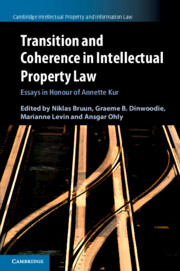27 results
ENSURING CONSUMERS “GET WHAT THEY WANT”: THE ROLE OF TRADEMARK LAW
-
- Journal:
- The Cambridge Law Journal / Volume 83 / Issue 1 / March 2024
- Published online by Cambridge University Press:
- 06 February 2024, pp. 36-61
- Print publication:
- March 2024
-
- Article
-
- You have access
- HTML
- Export citation
Foreword
-
-
- Book:
- The Cambridge Handbook of Investment-Driven Intellectual Property
- Published online:
- 16 March 2023
- Print publication:
- 23 March 2023, pp xi-xiv
-
- Chapter
- Export citation
8 - Universalism in International Copyright Law as Seen through the Lens of Marrakesh
- from Part III - The Scope and Mechanisms of International Intellectual Property Treaties
-
-
- Book:
- Intellectual Property Ordering beyond Borders
- Published online:
- 06 October 2022
- Print publication:
- 13 October 2022, pp 235-259
-
- Chapter
-
- You have access
- Open access
- HTML
- Export citation
2 - Injunctive Relief in Patent Law under TRIPS
-
-
- Book:
- Injunctions in Patent Law
- Published online:
- 28 April 2022
- Print publication:
- 12 May 2022, pp 5-25
-
- Chapter
-
- You have access
- Open access
- HTML
- Export citation
B - International Commitments and Constraints
- from Part I - Transition
-
- Book:
- Transition and Coherence in Intellectual Property Law
- Published online:
- 29 December 2020
- Print publication:
- 07 January 2021, pp 83-154
-
- Chapter
- Export citation
Part I - Transition
-
- Book:
- Transition and Coherence in Intellectual Property Law
- Published online:
- 29 December 2020
- Print publication:
- 07 January 2021, pp 11-208
-
- Chapter
- Export citation
Part II - Coherence
-
- Book:
- Transition and Coherence in Intellectual Property Law
- Published online:
- 29 December 2020
- Print publication:
- 07 January 2021, pp 209-486
-
- Chapter
- Export citation
Copyright page
-
- Book:
- Transition and Coherence in Intellectual Property Law
- Published online:
- 29 December 2020
- Print publication:
- 07 January 2021, pp vi-vi
-
- Chapter
- Export citation
42 - Transition and Coherence in Intellectual Property Law
- from Conclusion
-
-
- Book:
- Transition and Coherence in Intellectual Property Law
- Published online:
- 29 December 2020
- Print publication:
- 07 January 2021, pp 489-512
-
- Chapter
- Export citation
Preface
-
- Book:
- Transition and Coherence in Intellectual Property Law
- Published online:
- 29 December 2020
- Print publication:
- 07 January 2021, pp xiii-xvi
-
- Chapter
- Export citation
A - Forms and Institutions
- from Part I - Transition
-
- Book:
- Transition and Coherence in Intellectual Property Law
- Published online:
- 29 December 2020
- Print publication:
- 07 January 2021, pp 13-82
-
- Chapter
- Export citation
B - IP Overlaps
- from Part II - Coherence
-
- Book:
- Transition and Coherence in Intellectual Property Law
- Published online:
- 29 December 2020
- Print publication:
- 07 January 2021, pp 305-404
-
- Chapter
- Export citation
A - Intellectual “Property” and its Limits
- from Part II - Coherence
-
- Book:
- Transition and Coherence in Intellectual Property Law
- Published online:
- 29 December 2020
- Print publication:
- 07 January 2021, pp 211-304
-
- Chapter
- Export citation
C - New Agents and the Challenge of New Technologies
- from Part I - Transition
-
- Book:
- Transition and Coherence in Intellectual Property Law
- Published online:
- 29 December 2020
- Print publication:
- 07 January 2021, pp 155-156
-
- Chapter
- Export citation
Conclusion
-
- Book:
- Transition and Coherence in Intellectual Property Law
- Published online:
- 29 December 2020
- Print publication:
- 07 January 2021, pp 487-512
-
- Chapter
- Export citation
Contents
-
- Book:
- Transition and Coherence in Intellectual Property Law
- Published online:
- 29 December 2020
- Print publication:
- 07 January 2021, pp vii-xii
-
- Chapter
- Export citation
C - (Un-)fairness
- from Part II - Coherence
-
- Book:
- Transition and Coherence in Intellectual Property Law
- Published online:
- 29 December 2020
- Print publication:
- 07 January 2021, pp 405-406
-
- Chapter
- Export citation

Transition and Coherence in Intellectual Property Law
- Essays in Honour of Annette Kur
-
- Published online:
- 29 December 2020
- Print publication:
- 07 January 2021
10 - The Function of Trademarks in the United States
- from I - The Nature and Functions of Trademarks
-
-
- Book:
- The Cambridge Handbook of International and Comparative Trademark Law
- Published online:
- 18 September 2020
- Print publication:
- 24 September 2020, pp 178-191
-
- Chapter
- Export citation
2 - Overlap and Redundancy in the Intellectual Property System
- from Part I - Across Regimes
-
-
- Book:
- Across Intellectual Property
- Published online:
- 27 March 2020
- Print publication:
- 12 March 2020, pp 26-37
-
- Chapter
- Export citation



